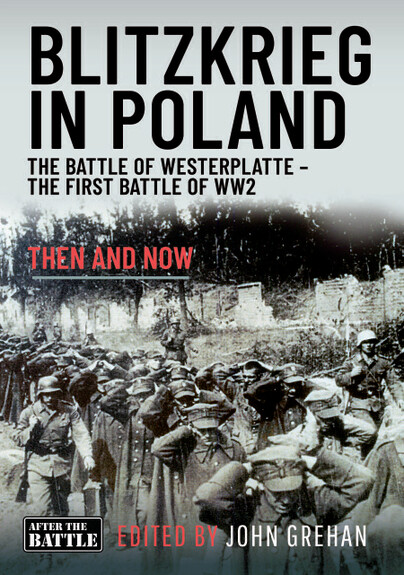Blitzkrieg in Poland (Hardback)
The Battle of Westerplatte – The First Battle of WW2
Imprint: After the Battle
Series: Then and Now
Pages: 128
Illustrations: 150 mono illustrations
ISBN: 9781036101732
Published: 30th June 2026
(click here for international delivery rates)
Need a currency converter? Check XE.com for live rates
The important Baltic port of Danzig was a ‘free’ city, an independent city-state. It had been part of Germany until the area around Danzig was handed to the newly independent state of Poland under the terms of the Treaty of Versailles after the First World War. Though surrounded by Poles, Danzig’s population was largely Germanic – and tensions between the Poles and the Germans in the region mounted throughout the 1920s and 1930s.
The Poles received permission from the League of Nations to establish a small military depot on the Westerplatte Peninsula which overlooked the approaches to Danzig port. If artillery was placed on Westerplatte it could potentially block all access to Danzig – it was, therefore, Hitler’s first objective in his invasion of Poland.
Secretly, the Poles had strengthened their defences on the peninsula and when, on 25 August 1939, the German battleship Schleswig-Holstein paid a ‘courtesy’ call to Danzig, the Poles at Westerplatte, under the command of Major Henryk Sucharski, were placed on high alert. The next morning, the Germans planned to seize Westerplatte, but the date for the start of the invasion was delayed after Hitler learned that Britain had just signed a defence pact with Poland.
Despite this, Hitler was resolved to continue with his plans and, regardless of the threat of British intervention, he rescheduled the invasion for 1 September 1939. At 04.48 hours that fateful morning Schleswig-Holstein unleashed a broadside on the defences of the Westerplatte – firing the first shots of what would become the Second World War. Minutes later a force of German marines, which had landed from the battleship earlier, charged the Polish defences. They expected an easy victory. But Sucharski’s men were ready.
Machine-gun, rifle and even artillery fire poured down on the Germans who were driven back. A second bombardment from Schleswig-Holstein was called for, and the Polish defences were hammered for fifteen minutes. The Germans attacked again and, once more, the Poles held them off, the Germans suffering almost 150 casualties. Sucharski had been expected to be able to hold out for twelve hours before reinforcements arrived; he held out all day.
The following day, Westerplatte was shelled both from the sea and the land, as well as bombarded for the air. But still the Poles defied the odds and refused to be beaten. Though none of the promised reinforcements arrived, Sucharski and his men continued to defy the Germans day after day.
Elsewhere, Hitler’s forces had crossed the Polish border and, by 6 September 1939, were in the outskirts of Warsaw. Finally, Sucharski’s officers agreed there was no longer any value in continuing the fight. Undefeated and unbowed, the Poles surrendered at 07.45 hours on 7 September, ending one of the most valiant stands of the Second World War.
There are no reviews for this book. Register or Login now and you can be the first to post a review!
About John Grehan
JOHN GREHAN has written, edited or contributed to more than 300 books and magazine articles covering a wide span of military history from the Iron Age to the recent conflict in Afghanistan. John has also appeared on local and national radio and television to advise on military history topics. He was employed as the Assistant Editor of Britain at War Magazine from its inception until 2014. John now devotes his time to writing and editing books.
The Battle of Stalingrad Then and Now (Hardback)
Stalingrad was not only the most-crucial battle on the Eastern Front, it was the main turning point of the whole Second World War in Europe. The Third Reich had suffered setbacks earlier, notably at El Alamein in North Africa in October 1942, but the scale of the fighting on the Eastern Front was incomparably larger than any of the other war fronts and it was the fate of the armies there that decided the outcome of the global conflict. After the demise of the German 6. Armee at Stalingrad in February 1943 it was clear that Nazi Germany would lose the war. This book brings together three After…
By Karel MargryClick here to buy both titles for £45.00



























